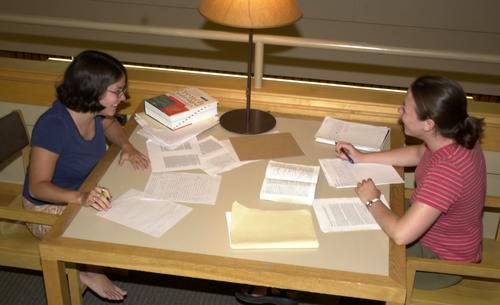Students Spend Summer Uncovering Missing Links in French History
Two students are spending the summer translating long lost French documents, and in the process are uncovering pieces of history.

For Carl Weiner, the W.H. Laird Professor of History and Liberal Arts, a chance encounter has allowed him to fill in vital details of political and social history for one town in France.
Weiner has traveled regularly to Esternay, a small town 60 miles from Paris, since the 1970s to work on what he calls, “the Poirrier collection.” A descendant of the Poirrier family, which had lived in the area for generations, knew he was a historian of France and asked if he was interested in examining several hundred handwritten letters in the attic of their ancestral home. In addition to the letters, the attic housed the remnants of archives kept by the Poirrier notaries from the 1770s through the 1890s. Since then, Weiner has brought boxes of French history to Northfield for translation and analysis.
“If you want to know anything about an area, about who lived in it, what their daily life was like, these notary archives are absolutely important,” Weiner said. “Notaries in the 18th and 19th century in France were financial and political brokers. They were business men, investment counselors and unpaid civil servants.”
Once back at Carleton, Weiner recorded, counted, collated, copied and transcribed the Esternay documents. What he found added important detail to recorded French history. In addition to the notary accounts, Weiner examined letters documenting an entire generation of correspondence between the Poirrier family, which included letters from children to parents, husbands to wives, and aristocratic clients. Coupled with the archives, the collection represents what Weiner calls “a micro-history of an area of France, from the end of the eighteenth-century to the end of the nineteenth-century.”
“In a sense, what you have here is a sort of X-ray of the political, social and economic life of this area for well over 100 years,” he said. “Then in addition you have these very fascinating letters. These [letters] illuminate questions about business, politics, marriage, divorce, childhood, education, sickness, health, in short about the everyday life of the people that lived in Esternay.” The breadth of the archives led Weiner to consider publishing the records on the Internet as a research archive to add context and setting to existing French history. Currently under construction, the Esternay archive is being helped along by two students who are translating the most important documents in the collection.
With unabridged French dictionaries and an eye for obscure French grammar, senior Mei Chin of Chicago, Ill., and senior Julia Cummiskey of Ardmore, Pa., spend part of their summer days translating the Esternay papers.
Their enthusiasm for the project is apparent: “Original 19th century French documents in a collection of this size are not generally available to undergraduates,” said Cummiskey, a history major. Chin, a French major, adds, “Getting to see what makes a town work is also amazing. Almost every kind of relationship is in these manuscripts.”
The two will spend the upcoming year translating letters, wills and ledgers, which can be challenging as some are damaged, others use arcane language and many are written in elaborate handwriting.
When the project is finished, the archives collected by Weiner will represent what he refers to as a “portrait of everyday life and everyday emotions,” in Esternay. For a region that witnessed the great French Revolution, the Commune of 1871 and other significant events, this archive is invaluable to Carleton.
Asked about what the archive holds for future students, Weiner answered, “Once this archive is complete, students will be able to go into it and come out with things that I haven’t even thought about looking for. It all depends on where they want to go with their research. It’s all at once everything and anything.”